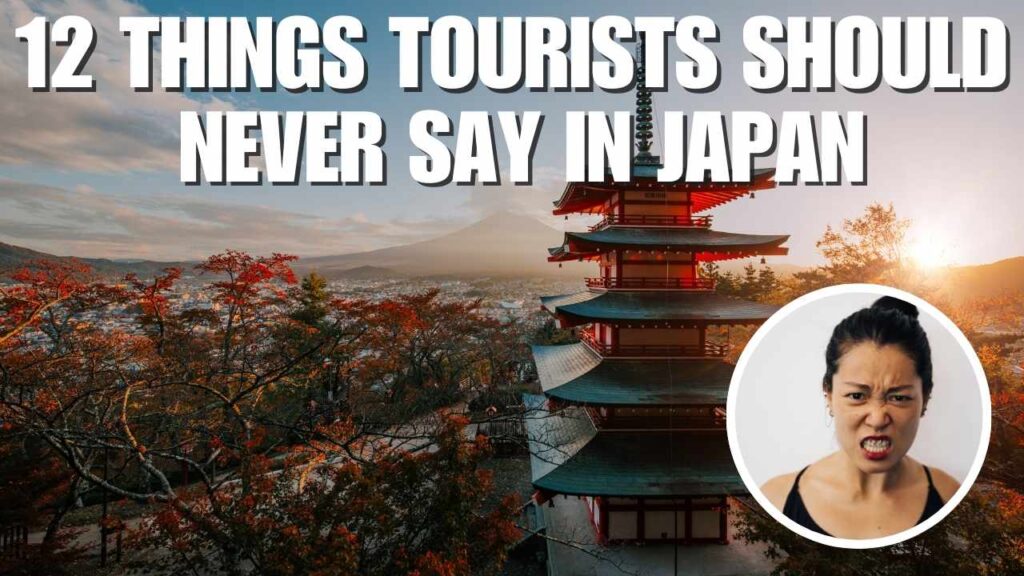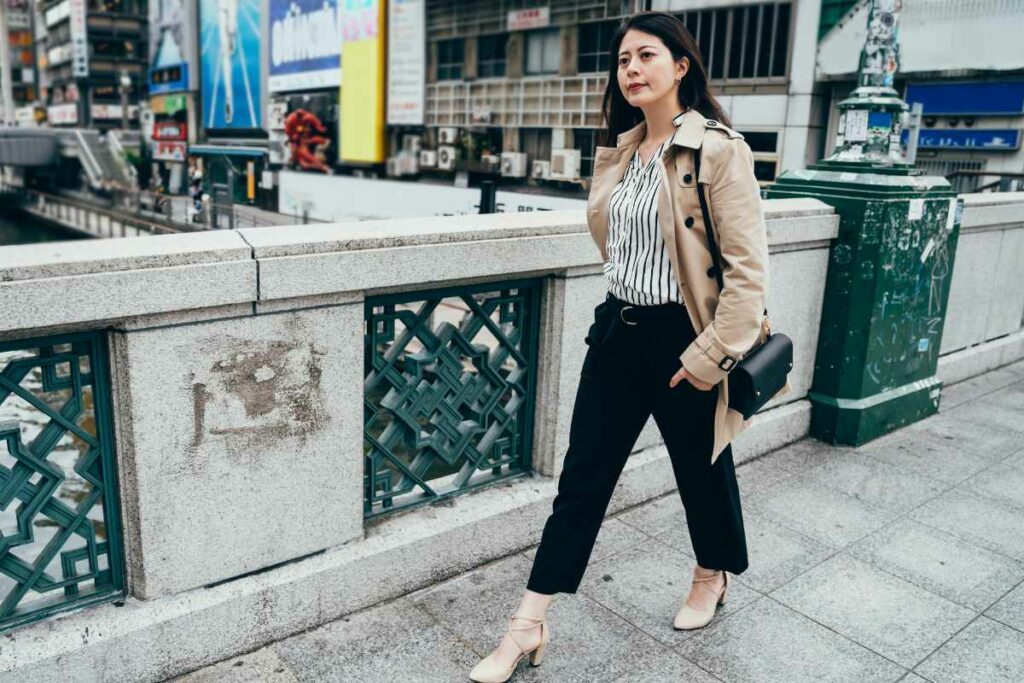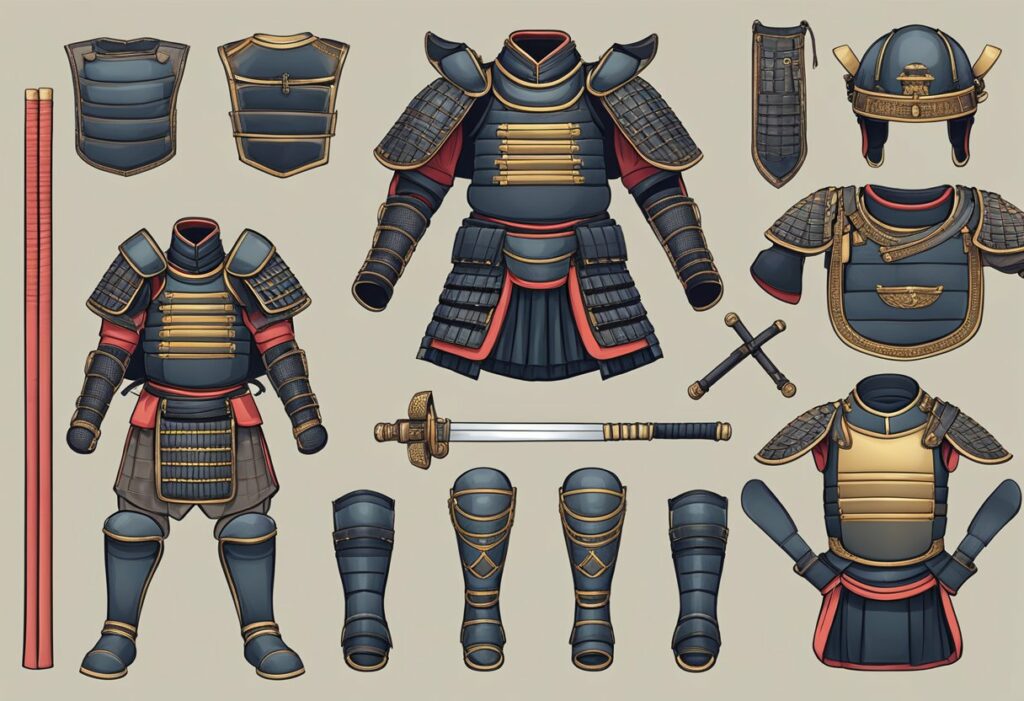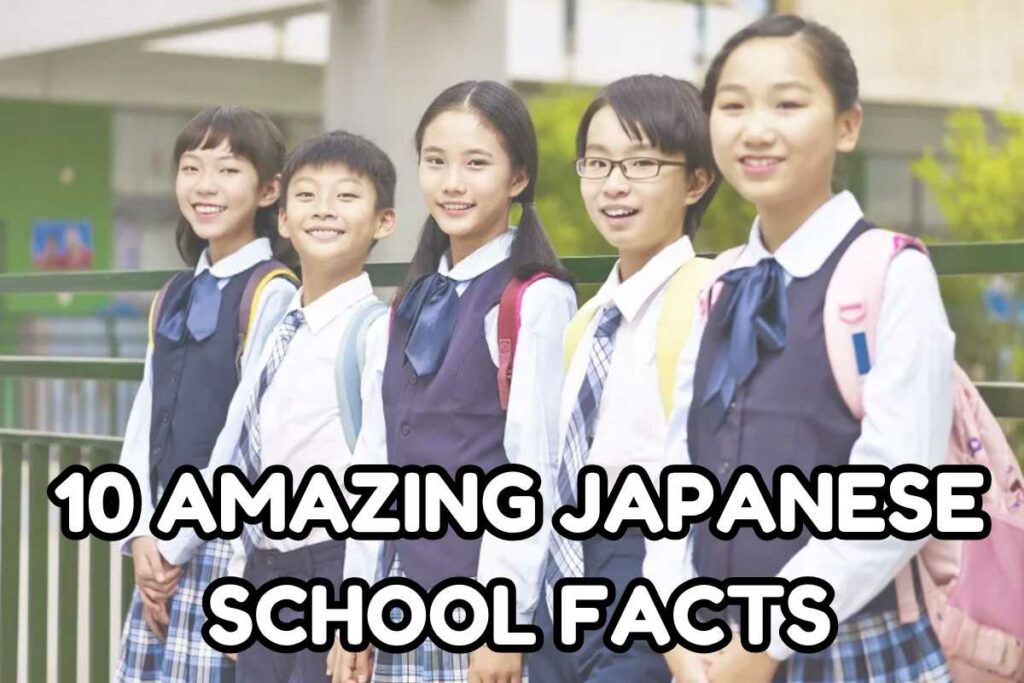Maiko. Geisha. Two important parts of Japanese culture that many foreigners struggle to separate.
There are differences, however as we’ll discuss in this article.
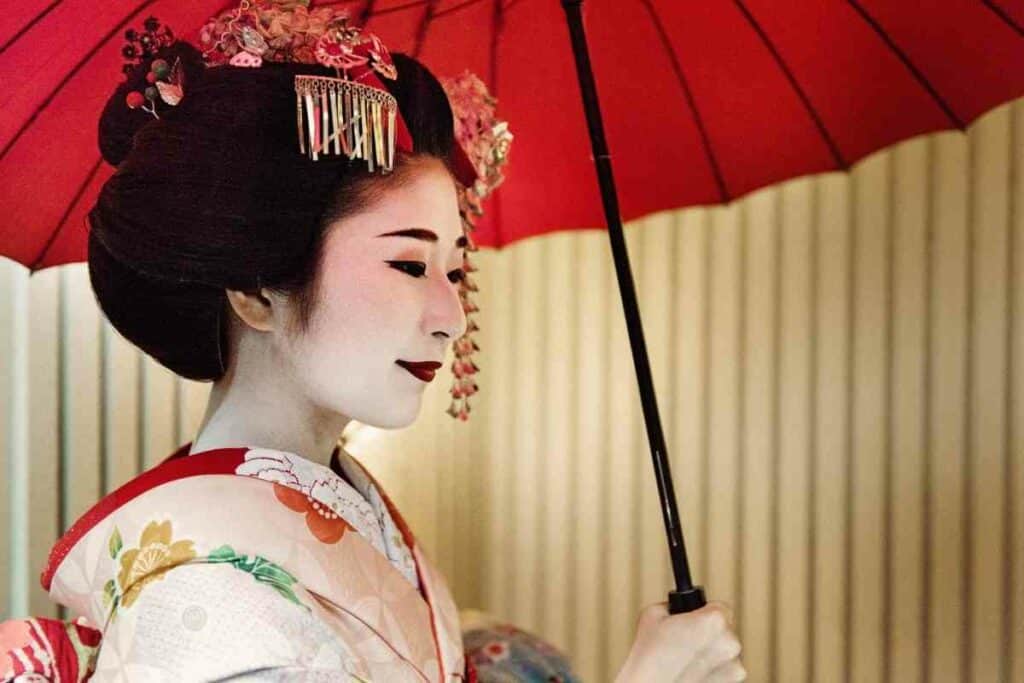
Unlike professions like the samurai, Geisha have continued to entertain for centuries, and travelers today are still likely to see these wonderous entertainers dotted around the country.
Before we explore the aesthetic differences between the two, let’s look in detail at what each term means.
Table of Contents
The Maiko
Coming from the Japanese “mai” meaning dance and “ko” meaning child, the Maiko is literally a dance child.
Less commonly heard of throughout the rest of the world, the Maiko is a trainee Geisha. She spends around five years training and learning about the “gei” (arts).
Maiko training typically begins when a girl is fifteen and lasts as long as six months (the preparation term).
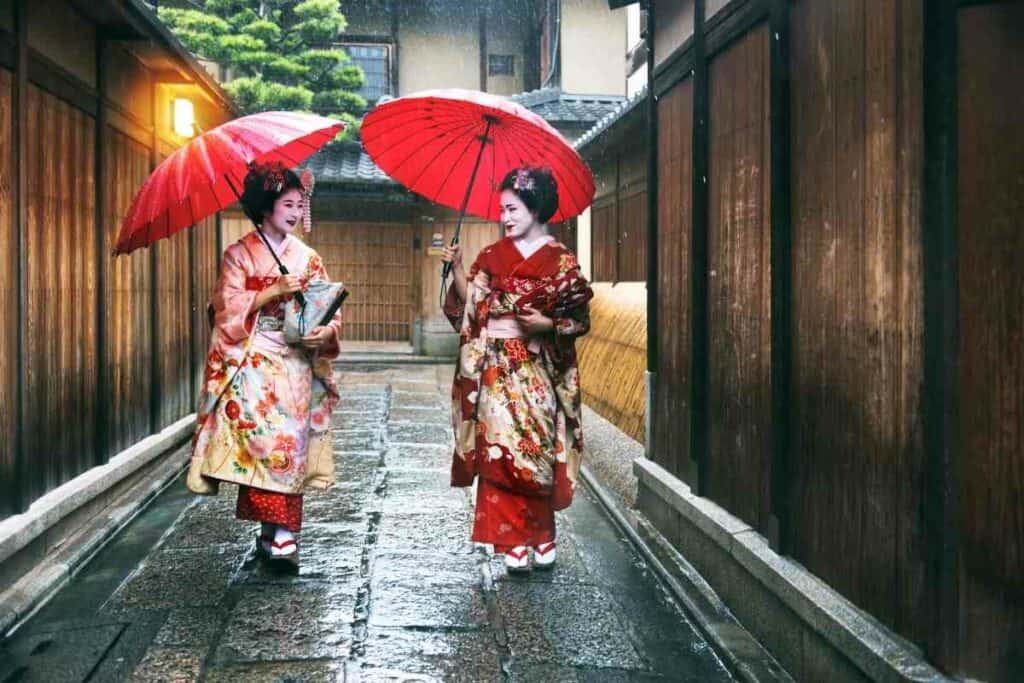
During this time, they are called “shikomi san”. Training is tough; the girls are not allowed to see or call their family, though letters are allowed.
Each shikomi san is paired with an Oneesan (sister) who is a mentor to them during the training.
The shikomi san also assists their Oneesan with clothing preparation and make-up before she goes to perform at the Ochava (tea house).
After Passing the Tests – The girl officially becomes a Maiko and works for a Geisha drinking/lodging house called Okiya. This is run by the house Okaasan, meaning mother, as this woman acts like the girls’ mother during their time as Maikos.
Through the Maiko training, the girls gradually improve their status before graduating finally as a Geisha. This ceremony is called Erikae, which means turning of the collar
It is possible to skip being a Maiko for girls aged over 20.
Maiko in the Past
In the past, young girls were often sold to an Okiya as young as five or seven years of age to become a maiko.
Thankfully, this practice is now outlawed and girls choose for themselves if they want to pursue this profession.
The Geisha
The word Geisha is an amalgamation of “gei” meaning arts and “sha” meaning person.
Thus, a Geisha is a woman who is trained in traditional Japanese music, singing, games, and dance.
Unlike many people believe, a Geisha is not a prostitute or a courtesan, they simply perform and entertain people with their skills.
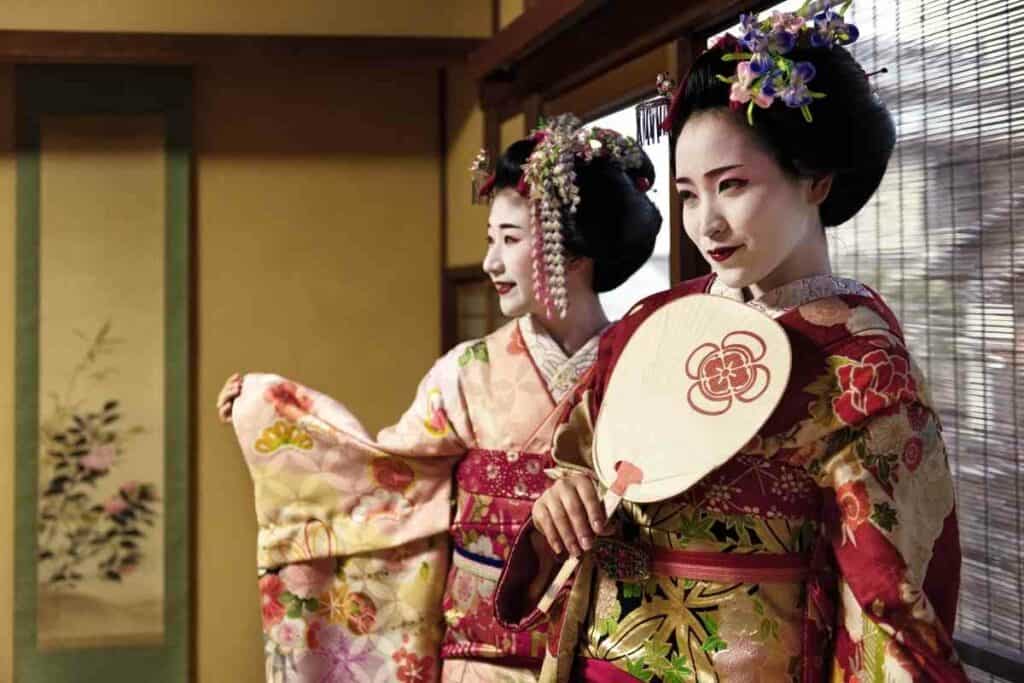
Geishas are considered to be culturally elite and pay close attention to aesthetics and beauty.
They are independent women who are considered to be highly-respected businesswomen in Japan – and ones who have eschewed the stereotype of becoming married mothers dependent on men for money.
Key Takeaway: A Geisha’s role is to entertain with dance and song as well as to have meaningful conversations with clients. In Tokyo, the term “Geisha” is common, while in Kyoto, the term is “Geiko”.
Maiko Vs Geisha: Differences in Appearance
Now we understand the differences between a Maiko and a Geisha in terms of terminology, it’s important to understand the differences in appearance and dress too.
Hair
Maiko tend to style their hair excessively; they style their hair to perfection and even sleep on a takamakura.
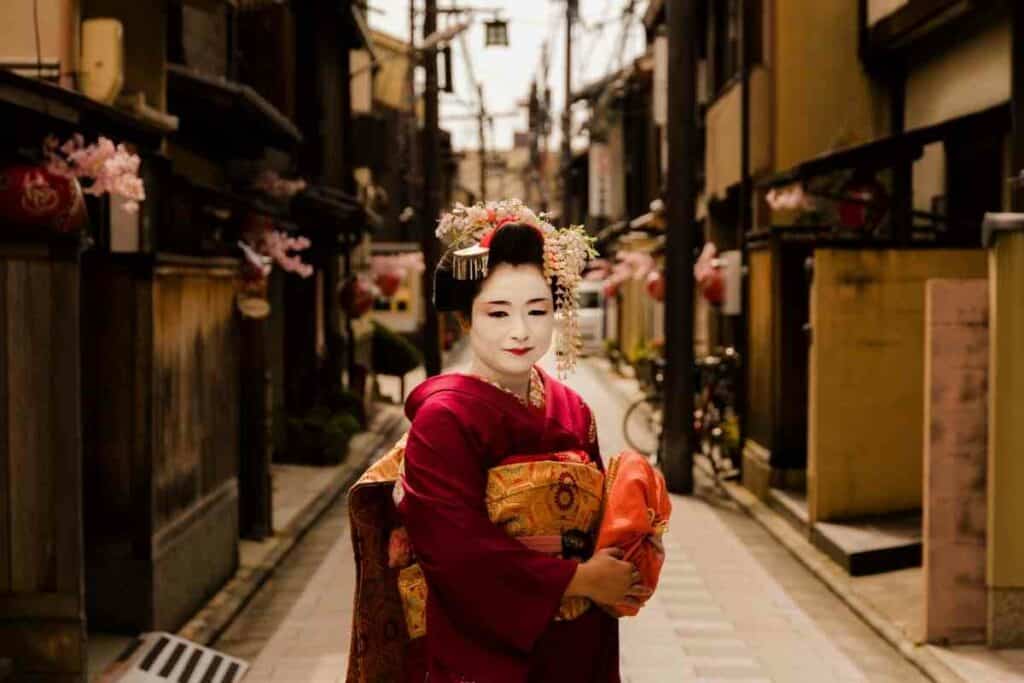
The term takamakura literally means “high pillow” and it’s a neck brace of sorts that prevents the Maiko’s hair from becoming disheveled.
Conversely – A Geisha is much more relaxed about her hair and will often wear a wig. Because of this, a Geisha’s makeup usually reaches their hairline, while a Maiko will show a small amount of makeup-free skin around their hairline.
A Maiko will change her hairstyle to mark each of the five apprentice stages. She will also have an elaborate flower comb called a Hanakanzashi, made out of ornaments and silk.
A Geisha, on the other hand, will have a simple Kanzashi (decorated comb).
Historically, it is believed that this Kanzashi doubled up as an item of self-defense thanks to their sharp pin.
The reason for the different hairstyles and use of wigs is that the hairstyles the Maiko wear are complicated and expensive.
Once a fully-fledged Geisha, it is more convenient to invest in a wig. It’s also healthier as a lot of Geisha lose their hair early due to all the excessive manipulation.
Pink and Red Makeup
When it comes to makeup, Geisha and Maiko look similar.
However, on close inspection, a Maiko will have red makeup around her eyes and more pink on their cheeks.
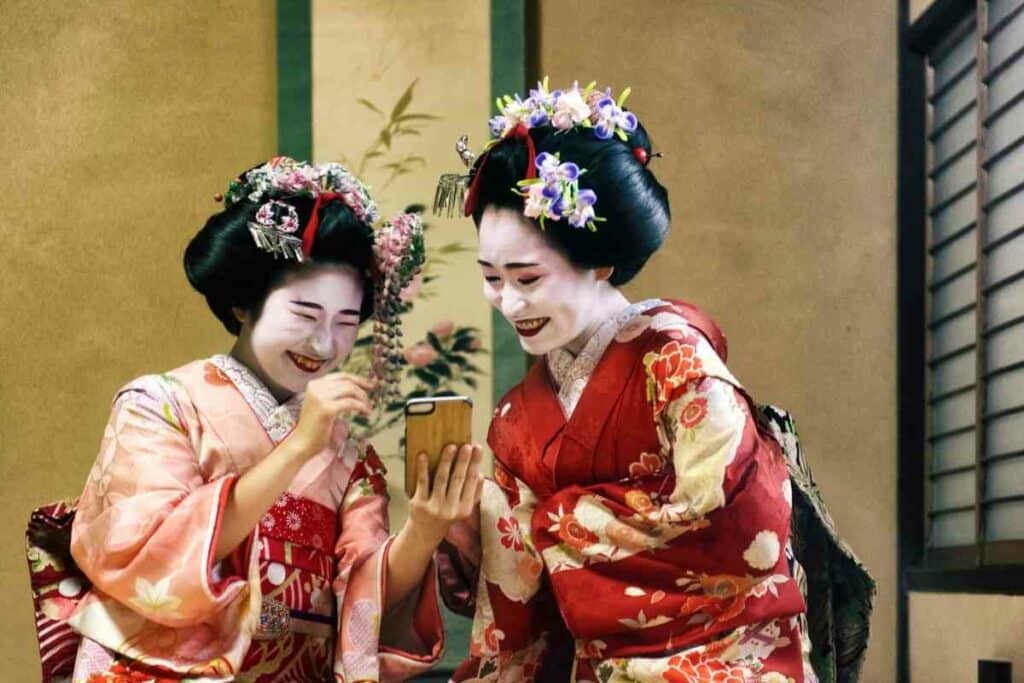
A Maiko will also have pink or red definition in her eyebrows underneath the black. Finally, Maiko only partially color their lips red.
Geisha, on the other hand, have a white face with black-outlined eyes. There will be a faint red on their eyebrows, underneath the black. A Geisha will have full or almost-full red lips.
Maiko Vs Geisha Kimono
Maiko kimonos are much busier than Geisha kimono.
Maiko will also wear longer sleeves – even down to ankle-length. A Geisha kimono has a more solid color and shorter sleeves.
A Maiko wears a red nagajuban (a simple robe worn underneath the kimono) while a Geisha’s will be much more subtle in color.
Obi
The Geisha wear obi (sash) that are thin and short.
Maiko, on the other hand, wear a wider, longer obi that almost hangs to the ankles.
Collar
Just like the kimono, a Maiko’s collar is decorative, embroidered and red towards the back of the neck.
Conversely, a Geisha wears a white collar.
Footwear
Being a Maiko is much more physically demanding as they wear high, wooden clogs called Okobo. These had red straps and have bells inside them.
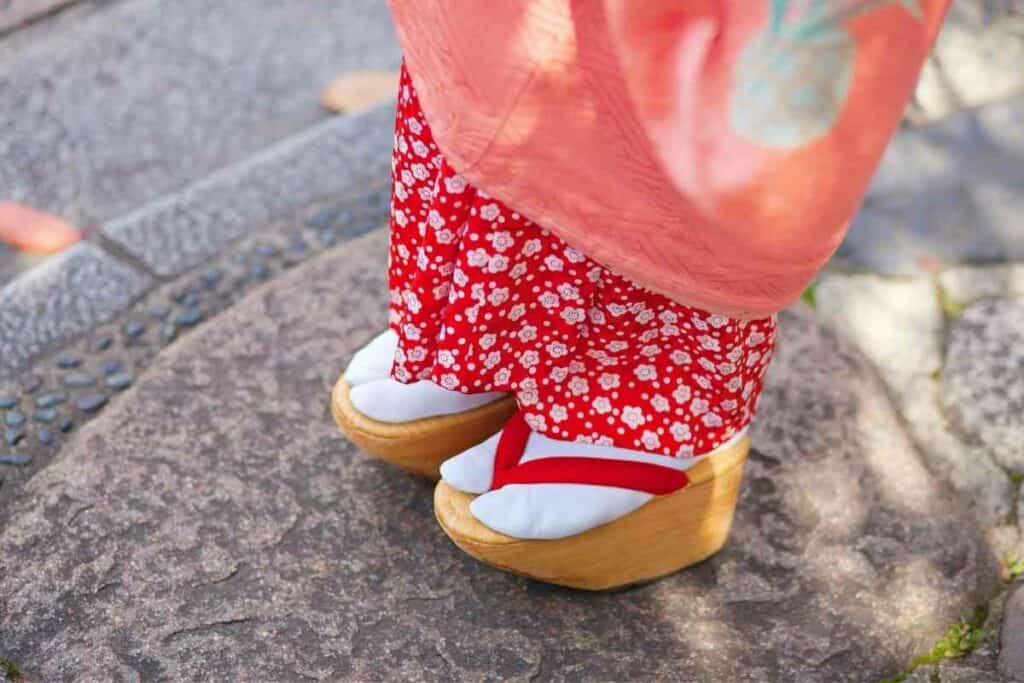
A Geisha, on the other hand, will wear lower shoes called Geta, which are flatter and much more comfortable.
Becoming a Geisha
After completing compulsory education, a girl who wants to become a Geisha will apply to become a Maiko.
There are different ways of doing this:
- Either someone known to them refers them to an Okiya owner or they can contact the Okiya directly.
- Another way of applying is to approach the Geisha union in their district. There will be an interview process.
Usually, Geishas choose to specialize in either music or dance and there is no age limit to being a Geisha – there are some women who have continued in the profession until age 90!
The Main Rule: A Geisha, however, must remain single and not marry. If she chooses to marry, she can no longer be a Geisha. The rule is simple: a Geisha is married to their art.
Training
During training, there are a lot of things Maiko have to learn for them to be a fully-fledged Geisha.
This includes:
- Walking with quiet steps, almost shuffling (which is difficult in wooden shoes)
- Etiquette
- The ways of men
- How to conduct a tea ceremony
- How to arrange flowers
- Classical fan dancing
- Umbrella dancing
- Calligraphy
- Learning to play the Samisen, a banjo-like instrument
- How to eat fish and tofu without the food touching the lips
- How to bow properly
As the training is so strict and contact with families is limited, many Maiko consider quitting.
Lots of Maiko don’t go on to become Geisha and quit at the end of their Maiko training.
How long do Geisha’s Train
Geisha training, known as “geisha school” or “okiya”, typically lasts around five years. During this time, young women, known as “maiko”, learn a variety of skills, including traditional dance, music, tea ceremony, flower arrangement, and conversation. They also learn how to apply makeup and dress in traditional geisha attire.
The training is rigorous and demanding, and maiko are expected to adhere to strict rules and regulations. They live in a traditional geisha house, known as an “okiya”, where they are supervised by an older geisha, known as an “older sister” or “onee-san”.
After completing their training, maiko become full-fledged geisha and are free to work independently.
However, it can take several more years to establish a reputation and build a clientele.
Take a look – 9 Japanese String Instruments
Maiko Vs Geisha Salary
Since a Maiko is an apprentice, she doesn’t earn a salary.
However, her accommodation, food, transport, classes, and clothes are paid for by the okiya. Some Maiko earn a small stipend.
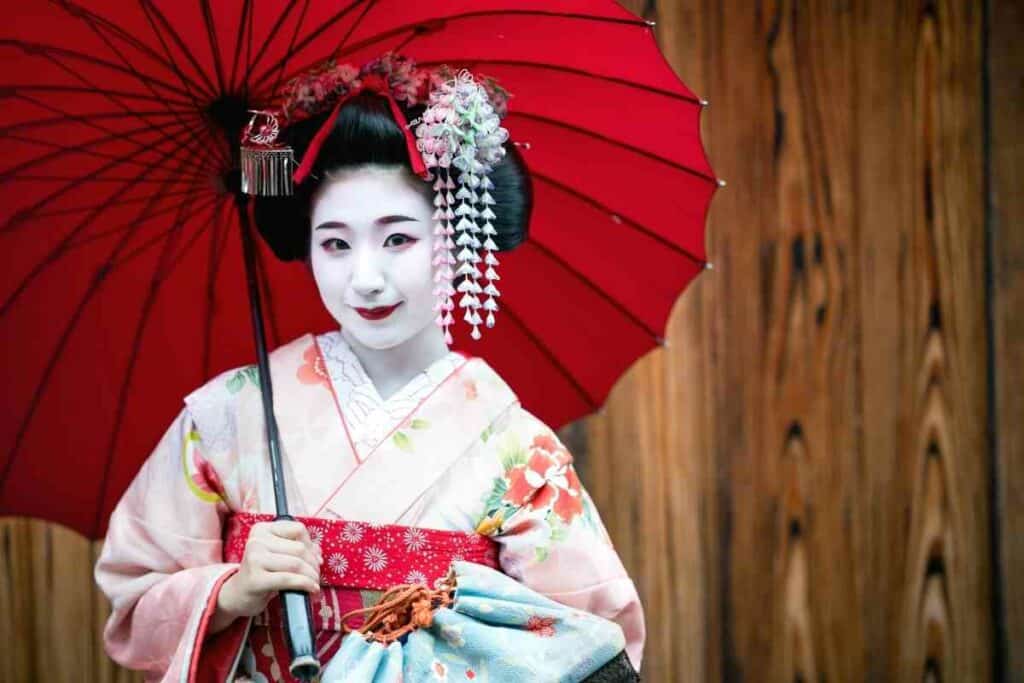
A Geisha earns a full wage, but her income will depend on how many engagements she is involved in and her skill level.
Just like actors in the performing arts industry, some geisha will earn much more than others.
The salary is believed to be around $3,000 per month up to $10,000+ for the best and most popular Geisha.
A Geisha will also receive gifts from clients. These might be expensive gems or silk kimonos.
What are the responsibilities of a Maiko and a Geisha?
They also serve tea and engage in social activities, such as attending parties and events. Additionally, they are expected to maintain a high level of professionalism, including adhering to strict rules of etiquette and dress.
Can a Maiko become a Geisha?
What is the role of Maiko and Geisha in Japanese culture?
They are known for their beauty, grace, and talent, and have been admired by both men and women. They have also served as cultural ambassadors, helping to promote Japanese arts and culture to the world.
How do Maiko and Geisha entertain their clients?
They also serve tea and engage in social activities, such as attending parties and events.
They are skilled at making conversation and putting their clients at ease, and are known for their wit and intelligence.
What are the personality traits required to become a successful Maiko or Geisha?
They must also be outgoing, personable, and able to make conversation with a wide range of people.
Additionally, they must have a deep appreciation for traditional Japanese arts and culture, and be willing to devote themselves to their craft.
How many Maikos and Geisha’s are there in Japan
The number of Maiko and Geisha in Japan has been declining over the past few decades. According to a survey conducted by the Ministry of Economy, Trade, and Industry in 2020, there were approximately 1,200 Geisha and Maiko in Japan.
This is down from around 80,000 in the 1920s.
The decline in numbers is due to a variety of factors, including changes in social and economic conditions, as well as a lack of interest among younger generations in pursuing careers as Maiko or Geisha.
Here are some estimated numbers of Maiko and Geisha in Japan over the years:
- 1920s: around 80,000
- 1950s: around 30,000
- 1960s: around 17,000
- 1970s: around 10,000
- 1980s: around 6,000
- 1990s: around 5,000
- 2000s: around 2,000
- 2010s: around 1,500
- 2020: approximately 1,200
Maiko Vs Geisha Conclusion
As we’ve seen, there are big differences when it comes to Maiko Vs Geisha!
The differences aren’t just in the role but also in appearance.
Knowing the subtle differences in dress, also helps us to understand why the graduating ceremony to become a Geisha from a Maiko is called Erikae (turning of the collar) because, quite literally, when the Maiko becomes a Geisha, she will stop wearing her decorative collar and begin wearing a plain white one instead, among other changes of course.
When traveling in Japan, tourist areas will also have “tourist geisha”.
These are not real Geisha but will dress up as a Geisha for photographs and tourism reasons.
How can you tell if they’re not a real Geisha? They’ll probably be struggling to walk in their shoes!
Hopefully, this article will help you know the difference between a Maiko and a Geisha when you next visit Japan! You’ll also be able to impress your friends with your new-found knowledge!
In Case You Missed It
- 12 Things Tourists Should NEVER Say in Japan
- Kissing Robot: Exploring the Popularity of the Chinese Kissing App
- Unlocking the Secret Dating Rituals Only Locals Know in Japan
- Samurai Armor: Ancient Protection for Japan’s Elite Warriors
- 10 Amazing Facts About Schools in Japan: Unique Traditions and Educational Practices
- Where can you see snow monkeys in Japan: Best locations and viewing tips

